This article was inspired by and is dedicated to Herr Paul Reed (Twitter @sommecourt), who tweeted images of von Gillhaußens Tomb in Berlin a short while ago. I was intrigued what could be found about the man resting below it.
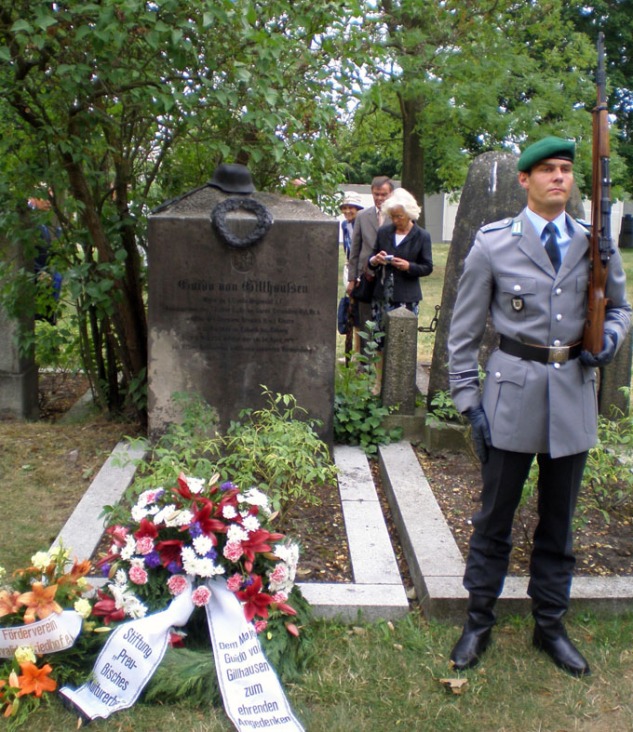
The tomb on the Invalidenfriedhof in Berlin (With Bundeswehr Honor Guard), after restoration in 2008
Guido Pankratius Hermann von Gillhaußen was born on the knightly estate of Esbach near Coburg (Thuringia) on the 12th of May 1870. His father was Benno von Gillhaußen (a former company commander in Infanterie-Regiment Nr. 13), his mother Helene von Gillhaußen, a born von Witzleben. Let me start with a basic military “curriculum vitae” up to WW1
After visiting the “Educational Institue for Boys” in Taubold, the Grammar school at Ernestin and the Bensberg Cadet School he joined the army in October 1889.
01/10/1889 Fahnenjunker in Infanterie-Regiment Herwarth von Bittenfeld (1. Westfälisches) Nr. 13 in Münster
14/05/1890 Promotion to Fähnrich
18/01/1891 Promotion to Secondelieutenant
05/06/1900 Promotion to Premierlieutenant
14/09/1900 Inspecting officer in the War Academy in Potsdam
05/06 – 09/07/1901 Infantry shooting school
1902 Garde du Corps
07/04 – 01/07/1903 1. Garde Regiment zu Fuß (1st Regiment of Guards)
16/02/1904 Kaiser Franz Garde Grenadier Regiment Nr. 2
27/01/1905 Military tutor to Prince August Wilhelm of Prussia
01/04 – 13/06/1906 Supervising officer in the Garnisions-Lazarett II (military hospital) Berlin
14/06/1906 Promotion to Hauptmann and Company commander
18/05/1908 Commander of Fortress Küstrin
22/04/1914 Transfered to Garde-Grenadier-Regiment Nr. 3
Von Gillhaußen was not only an officer, he also spent a lot of time pursuing the arts. He liked to paint, found the time to study music at the private academy of Gottfried Adolf Stierlin in Münster (Westphalia) and wrote patriotic songs and poems.
Because of a chance meeting in the Harz Mountains on the 16th of July 1912, he is even became friends with Franz Kafka, who mentions Gillhaußen in his “Travel Diaries“.
Gillhaussen’s lasting fame was no result of his artistic works or military skills, it originates from a letter he sent to the Crown Prince of Prussia on the 3rd of August 1914, three days after the declaration of war.
Berlin S.O., 3rd of August 1914
Mariannenplatz 20
What I saw in the night of the 3rd of August 1914, written at 2am.
How will the war progress? It will not be over soon. It won’t be against one enemy only. Many enemies pass my vision and I see Belgium inflicting terrible wounds with boundless savagery. In the west I see France, beaten and raped by England, an England that will become our most significant enemy. I see us fighting in Africa, but it’s white people who try to annihilate us. Italy hurries to side with England, Russia and France. On the Balkans it’s Serbia and Romania. I try to struggle against Romania, but it stays. I can not believe it, but it stays. Russia causes trouble, but it will succumb even if aided by Japan. Just like England is aided by America. I see Roosevelt offering bread and wine to England’s King. He is clapping him on the back and presents the King with money, a powder horn, a dagger and lead bullets. Roosevelt seemed to be our friend!?!
The War will be terrible and will last for many years. More enemies appear in countries all over the world and they hurry to join the war on England’s side. All people of the Earth are swallowed by the war. I see war from North-America to Australia, from Serbia to Japan up to the Cape of Good Hope. England is everywhere. It is hiding in the governments of our enemies and rules brutally and egoistically. All bow to England, there is no exception. Is that possible? Germany is breaking, 1918 will be worst.
It seems the war will end in 1920, or is it a ceasefire only? It seems like it. How long will it last? Will the Kaiser live to see 1921?
I see the Kaiser, wearing his crown and ermine cape, sawing off the legs of his throne. His ermine cape looses color, it turns grey and slowly crumbles into dust. His crown shrinks, gets smaller up until the Kaiser himself melts away.
It seems to me as if England receives its death thrust in Egypt and India. Germany is terribly weakened and it will take 30 years until it recovers. Russia awakens and fights America for the possession of the future. God be with us!
Guido von Gillhaußen
Hauptmann, 6. Kompanie, 3. Garde-Grenadier-Regiment
The letter was sealed and handed over to Prince Frederic William of Prussia who opened it in autumn 1915 and then sent it back to Gillhaußen. After Gillhaußens death the letter was rediscovered by the executor of his last will and testament.
In May Gillhaußens elder brother (Oberst Curt von Gillhaußen) published it for the family. By indiscretion copies of the publication found their way to America where they were published in the late 1918.
Further military service
19/08/1914 Skirmishes at Héron (St. Donat)
23/08/1914 Skirmishes at St. Gerard
29/08/1914 Skirmishes at St. Quentin, Colonfay. Severly wounded by Shrapnel (Head and right shoulder), rifle bullet injures four fingers of the right hand.
30/08 to 03/09/1914 Hospital in Wiège
08/10/1914 Promotion to Major
04/09 to 10/12/1914 Further medical treatment in Aachen
11/12/1914 to 16/06/1915 Military Hospital in Wiesbaden
17/06-02/07/1915 Ambulatory treatment in Berlin
02/07/1915 Transfered back to the Front
03/07/1915 to 31/05/1916 Staff of the Gardekorps
01/06/1916 Commander of the Reserve Batallion of the 3. Garde-Grenadier-Regiment
10/06 to 20/06/1917 Excision of the tonsils, Charité in Berlin
21/06 to 03/07/1917 Ambulatory treatment by Geheimrat Prof. Dr. Kilian in Berlin (nervous debility)
04/07 to 15/08/1917 Health resort in Bad Kolberg (anaemia)
17/09 to 22/09/1917 Training course with Sturmbataillon of 1st Army
15/10 to 18/10/1917 Training course “Army Gas School”, Berlin
04/04/1918 Battalion commander (Fusilier-Batallion) of Garde-Grenadier-Regiment Nr. 5
Most of the above information has been collected by Major a.D. von Eberhardt (Association of Officers of the former 3rd Regiment of Guards).
Von Gillhaußen was not lucky. All together he only spent 33 days on the Western Front. In 1914 he had been wounded after only 19 days of service. In 1918 it took only 14 days.
“On the Morning of the 24th of April 1918, he (von Gillhaußen) was leading an attack near Villers-Brétonneux near Amiens. Leading from the Front and setting an example with his courage he was severly wounded at 1030 in the Morning. A large piece of shrapnel from a high explosive shell smashed his left thighbone, smaller pieces hit his right arm and heel. Even worse than that he was suffering from Gas poisoning (Gelbkreuz = Mustard Gas) and there was the danger that the gas had entered his wounds” (1)
Another account reads:
“In a stretch of English made trench we find our new Major von Gillhaußen and with him the the other staff officers of the Fusilier-Battalion. At noon we get attacked by English infantry and 8 tanks from the direction of the village of Cachy. Our Major jumps out of the trench, spreads out his arms and bellows “Follow me! 9th company needs our support”. He leads and we follow him. On his breast and round his neck I can see his gleaming medals. Shortly afterwards he goes down, fatally wounded. With him we not only lost a famous Poet, whose song “Wir nahen in Demut. Gott Dir, Du Allmächtiger” (To you we walk humbly, almighty God) our recruits sang after taking their oath, we also lost a real man and a true Prussian guards officer. We loved him for his fairness and his austerity. He loved his fatherland and paid the ultimate price for his love. Loyal unto death, just as it reads in one of his poems. Umbrüllt und dereinstens der Donner der Schlachten und dräuet uns grimmig auch Schrecken und Not: Wir halten den Treueschwur, wills tagen, wills nachten! Ob Sieg oder Sterben: Treu bis zum Tod! (When the Thunder of Battle comes screaming and horror and need awaits us, we will be loyal. In day and at night, in victory and dying. Loyal unto Death! ) (2)”
According to von Eberhardt, Gillhaußen was transported to Feldlazarett 16 and from there (on the 28th of April) into the military hospital (Luisenhospital) in Aachen. The mustard gas had indeed infected his wounds, so his left leg had to be amputated. All further treatments were to no avail. Gillhaußen died on the 2nd of May 1918 at 0800 in the morning. His body was brought to Berlin and was buried on the “Invalidenfriedhof“. The highly decorative gravestone survived World War 2 and the construction of the Berlin Wall and was restored by the association “friends of the Invalidenfriedhof” in 2008.
As Gillhaußen was a Knight of the Order of St. John his name is also remembered in the stained windows of the Church of the Holy Mother in Slonsk (Poland), a former Church of the Order of St. John (Window 1, behind the altar).
Gillhaußens medals included:
Iron Cross 2nd and 1st Class, Prussian Order of the Red Eagle 4th Class, Prussian Order of the Crown 4th Class, Saxon-Ernestinian House Order (Knights Cross, 1st Class with Swords), Hessian Order of Philip the Magnanimous (Knights Cross 2nd Class), Saxon Arts and Science Medal in Silver, Austrian Order of Franz-Joseph, Romanian Order of the Star, Prussian Order of St. John (Knights Cross), Lippe War Merit Cross for Combatants.
Sidenotes:
Hauptmann Leo von Gillhaußen (Guidos youngest brother), was killed on the 6th of November 1918 south-west of La Croix-Hautrage by shellfire. He is buried at Hautrage near Mons.
Oberst Curt von Gillhaußen (Guidos elder brother), served as adjutant to His Royal Highness Edward, Duke of Sachse-Coburg and Gotha, survived the war and passed away in 1956.
Sources and further reading:
1. Major a. D. von Eberhardt (Schriftleiter der „Mitteilungen des Vereins der Offiziere des ehemaligen 3. Garde Regiments zu Fuß e.V.“) Archiv 3. Garde Regiment z. F.
2. War Diary of Fritz Robert Buschmann,
Mettmann, vom Garde Grenadierregiment Nr. 5.: Der Heldentod des Majors v. Gillhaußen vom Garde-Grenadier-Regiment Nr. 3, in: Das Ehrenbuch der Garde, Die preußische Garde im Weltkriege 1914–1919
Albrecht von Stosch, Oberstleutnant a.D.: Das Garde-Grenadier-Regiment Nr. 5 1897 – 1918. Nach amtlichen Kriegtagebüchern und Mitteilungen von Mitkämpfern bearbeitet (1922)
also used various editions of the Rangliste der königlich preussischen Armee
Post scriptum
Should you ever be able to visit Berlin, make sure you take some time to visit the beautiful memorial of the 5th Guard Grenadier Regiment in the Stabholz Garden in Spandau. When war broke out in 1914, the officers and soldiers of the Regiment vowed that they would erect an appropriate monument for the brothers in arms that would be killed in the battles to come.

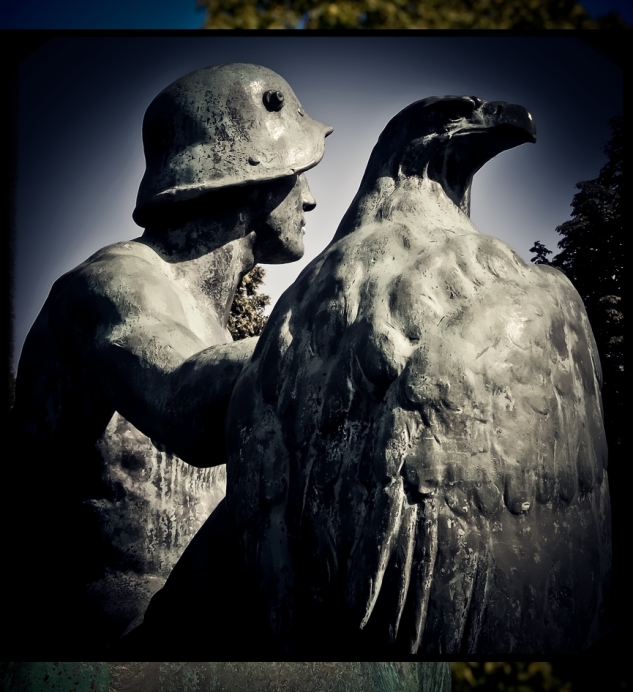
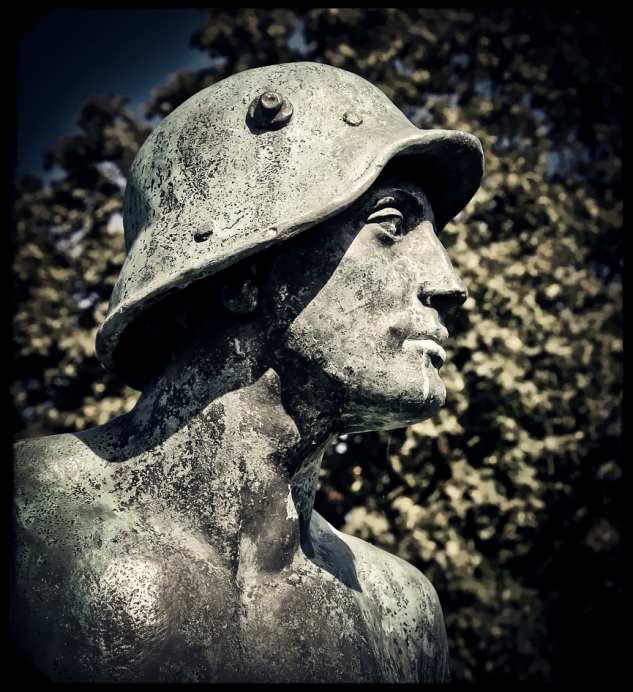
In May 1922 the monument was unveiled. The bronze statue is called “Die Wacht” (The Guard) and was designed by August Schreitmüller (1871-1958). It shows a soldier armed with a short sword, wearing only a steel helmet and a loincloth and an eagle sitting at his feet. The memorial is dedicated to the 4122 casualties the Regiment suffered during the Great War.
The inscription reads: Seinen im Weltkriege / gefallenen Kameraden / Das Garde-Grenadier-Regiment Nr. 5 (To the comrades killed in the Great War)
Gottmituns.net now with own proofreading service. Thanks to the charming Dawn Monks (@DawnMonks) for ironing out inconsistencies and errors. (Follow her on Twitter)


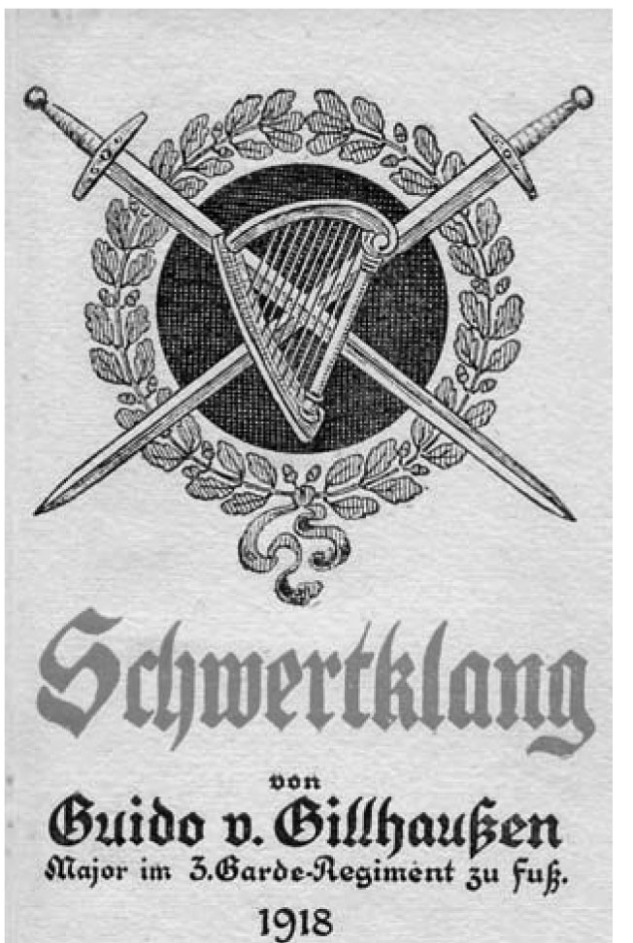

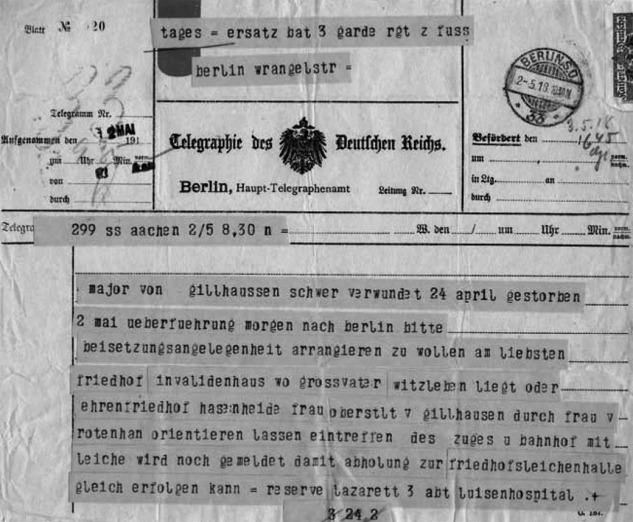


Amazing story. He was quite the prophet. Thanks for writing this up.
Reblogged this on History Stuff That Interests Me and commented:
Fascinating human interest story from my friend at Gott Mit Uns.
Can you give us any information on the honor guard at the grave site? The green beret appears modern but his tunic perhaps inspired by the more traditional German Army uniform? He is also shouldering a WWII vintage Karabiner 98k if my eyes are not fooling me.
Indeed an amazing story, thanks for sharing it.
http://en.wikipedia.org/wiki/Wachbataillon
And indeed the Wachbataillon uses vintage k98s for ceremonial duties
Thank you, very appropriate for the Major’s grave…and as usual, I learned something new about German military traditions. They are authorized to use the K98s because the modern H&K does not translate well conducting the historical rifle drills. Interesting!